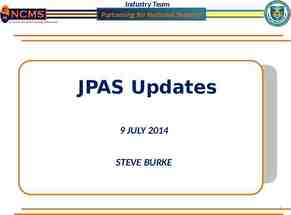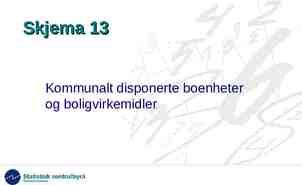Enculturation of Hospitalized Patient Encounter Safety Components
13 Slides5.25 MB
Enculturation of Hospitalized Patient Encounter Safety Components using Hybrid Clinical Onboarding Methodologies Margaret B Deanes, MSN, RN, CNOR, RNFA Advanced Nursing Education Specialist Debra D Gillis, MSN-Ed, RN, NPD-BC, CEN, CHSE, Team Coordinator of Simulation Kelsey M O’Connor, MSN-Ed, RN, CNOR, Simulation Specialist VHHA Patient Safety Summit Sentara Healthcare Norfolk Virginia February 2021
Statement of Problem Historic need to validate new nurse assessment & documentation skills in controlled environment facilitated by nursing professional development practitioners COVID-19 Pandemic reduced clinical exposure for new graduate clinicians limiting application of knowledge Picture taken prior to masking mandates
Background Picture taken prior to masking mandates Sentara Healthcare consists of 12 hospitals in Virginia and North Carolina 1,800 New nursing clinicians hired per year General Nursing Orientation (GNO) revised in Q3 2020 to increase focus on patient safety
New Patient Assessment Encounter Patient Assessment Additional Documentation Practice Documentation of Assessment Barcode Medication Scanning Bedside Report of findings
Patient Assessment Part 1 Orientation to manikin, objectives, & hospital room to new hires Objectives: Patient assessment Medication Administration Report Documentation of assessment findings Assessment validation Part 2 Orientation to computer document folders, login process, patient assignment & self guide booklet Objectives Documentation– Critical lab result Manage Orders – MD telephone medication order Documentation – Skin assessment with annotated image Documentation validation
Patient Assessment Analysis: Continuous & ongoing; focusing on each aspect of station design Expected end products: Accurate assessment findings Organized hand-off Correct and safe administration of medication Accurate documentation of assessment in the EMR Successful documentation of critical components of patient safety
Results Pulse check satisfaction surveys Meaningfulness Sense of safety Quality of instructors Overall enjoyment 4.7/5.0 average satisfaction
Conclusions Impact: New nurses with validated knowledge and key behaviors upon starting new roles Supports provision of safe and efficient care Applicability: Other health systems and settings
Conclusions Barriers: Cost of high fidelity equipment Space to store manikins Provision of education with current restrictions Availability of qualified education staff Limitations Correlation to patient safety outcomes Variety of actual patient scenarios
Contact Information Margaret Deanes: [email protected] Debra Gillis: [email protected] Kelsey O’Connor: [email protected]
References Ackerman, A., Kenny, G., & Walker, C. (2007). Simulator programs for new nurses' orientation. Journal for Nurses in Staff Development: JNSD: Official Journal of the National Nursing Staff Development Organization, 23(3), 136-139. Conroy, P. & Hankamer, B. (2012). Bringing clinical orientation into the 21 st century with the use of simulation. Clinical Simulation in Nursing, 8(8), 401-402. Dunbar, K. & Radsliff, E. (2012). Integrating simulation into hospital nursing orientation. Clinical Simulation in Nursing, 8(8), 401-402. Green, V. (2016). A different new nurse orientation program. Journal for Nurses in Professional Development, 47(1), 32-36. Joswiak, M. (2018). Transforming orientation through a tiered skills acquisition model. Journal for Nurses in Professional Development, 34(3), 118-122. Kennedy, J., Nichols, A., Gibbs, H., & Arafeh, J. (2012). Nursing orientation: are we missing the mark? Journal for Nurses in Staff Development, 28(1), 24-26. 255-260.
References Kozub, E., Hinanada-Laserna, M., Harget, G., & Ecoff, l. (2015). Redesigning orientation in an intensive care unit using 2 theoretical models. AACN: Advanced Critical Care, 26(3), 204-214. Lott, T. (2006). Moving forward: creating a new nursing services orientation program. Journal for Nurses in Professional Development, 22(5), 214-221. Ragsdale, M. & Mueller, J. (2005). Plan, do, study, act model to improve an orientation program. Journal of Nursing Care Quality, 20(3), 268-272. Rivera, E., Shedenhelm, H., & Gibbs, A. (2015). Improving orientation outcomes. Journal for Nurses in Professional Development, 31(5), 258-263. Steffan, K. & Goodin, H. (2010). Preceptors’ perceptions of a new evaluation tool used during nursing orientation. Journal for Nurses in Staff Development, 26(3), 116-122. Woolwine, S., Romp, R., & Jackson, B. (2019). Game on. Journal for Nurses in Professional Development, 55(5),


















